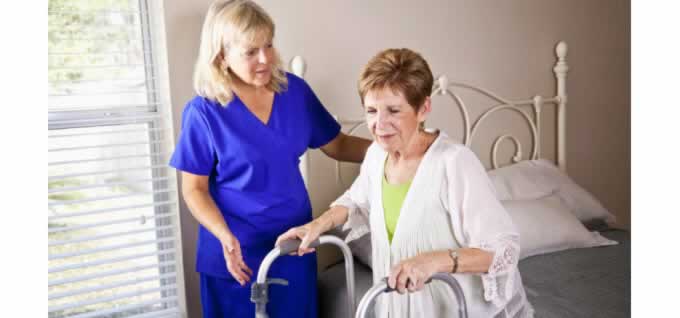How to Safely Use Your Walker
Although more than twice as many older adults use canes rather than walkers, a 2009 study found that seven times as many injuries were associated with walkers. According to this study, approximately 87% of fall injuries suffered by older adults (age 85+) happened when using walkers, whereas only 13% happened when using canes. One of the main conclusions of this study is:
“It might be beneficial to increase the amount of time devoted to
fitting aids and educating people how to use canes and walkers safely.”
We should not assume that using a walker is straightforward – you just hold the handles and walk. This is not so. To avoid slipping, sliding or falling, you must learn how to use your walker and walk with your walker safely.
Here are the main tips for using your walker safely:
- What you wear when using a walker is an important safety issue: Clothing should be comfortably loose but not able to become entwined with your walker. Wear nonskid footwear – shoes or slippers with rubber, not leather, soles. Bare feet or wearing just socks is not advised when using a walker. Get into the habit of wearing proper footwear.
- Tripping is more common than slipping with a walker so make sure your living and bedroom areas are clear of clutter. You should remove loose rugs and ensure all carpeting is nailed down. Wipe up floor spills quickly to prevent a fall.
- Make sure the tips of your walker are in good repair. It is easy and inexpensive to replace worn tips or glide skis – so have an extra set on hand.
- Ensure the grips (handles) of your walker are comfortable to use and that the grip itself won’t slip around the walker handle.
- If you have a basket, tray or other accessory attached to your walker, make sure these items are attached properly.
- If your walker folds up for storing convenience, make sure it is locked open before using your walker.
Getting up from a chair:
- Put the walker in front of your chair and slide forward in the chair.
- With your hands on the arms of the chair, slowly stand up. Do not use the walker to hold onto while attempting to stand up from a chair. Use your arms to lift you from the chair, gain your balance, then reach with one hand for the centre of the walker.
- Bring your walker towards you so that you are standing just inside the walker. Transfer both hands to the handles of the walker.
- Stand with your walker until you feel balanced and ready to walk.
Walking with your walker:
- When you are ready to walk, move the walker forward about one footstep ahead of you. Ensure that all four legs are firmly on the ground.
- When walking, place your strong foot forward first, then move your other foot forward. Pick up and move the walker, then, when the walker is firmly back on the ground, take your next steps.
- Pick up and move your walker ahead of you
- Take a step with one foot then the other
- Have both feet on the ground before you again move your walker
- Pick up and move your walker ahead of you
- Take a step with one foot then the other
- Have both feet on the ground before you again move your walker
- Practice these steps until you are comfortable with them
- Do not hold your walker too close to you or too far away. Take small, confident steps to establish a comfortable and safe rhythm with your walk.
- Look ahead while you are walking, don’t look down at your feet. You should be confident that you have removed all items that could cause you to trip. Looking ahead helps you gain and maintain good balance.
Sitting down:
- Stand with your back to the chair and the back of your legs touching the chair.
- Set the walker firmly on the floor in front of you, slightly away from you so you can bend your body towards your walker. Your backside should be over the centre of the chair.
- Place your weight on your legs, as much as possible.
- Keep one hand lightly on your walker while you reach for the armrest with your other hand. Firmly grasp the armrest and transfer your weight to that arm and your legs. Next, move your other hand from your walker to the other armrest and transfer the rest of your weight to that arm.
- Slowly sit down and slide backward into your chair. If you find you can’t hold your weight with your arms while you slowly sit down, try bending your knees more.
Please remember that the above points are part of a sensible guideline. These points are for information purposes only. You should always seek the advice of your medical professional or other qualified health provider with any questions you may have with regard to fitting and using a walker.
iStevens, J. A., Thomas, K., Teh, L. and Greenspan, A. I. (2009), Unintentional Fall Injuries Associated with Walkers and Canes in Older Adults Treated in U.S. Emergency Departments. Journal of the American Geriatrics Society, 57: 1464–1469. doi: 10.1111/j.1532-5415.2009.02365.x




 and get Cash rewards!
and get Cash rewards!